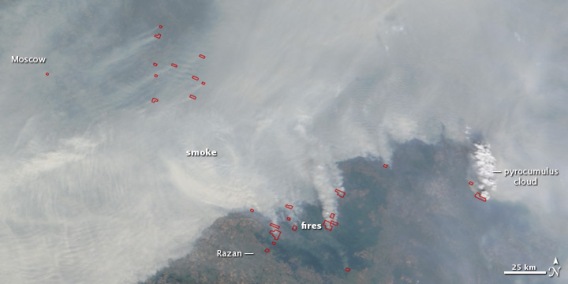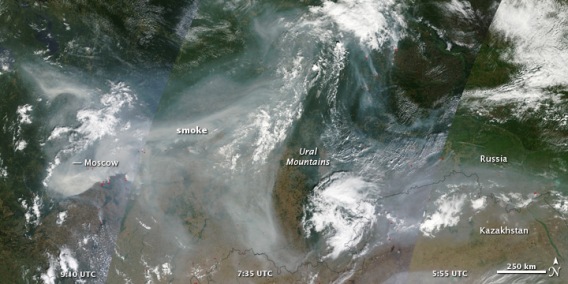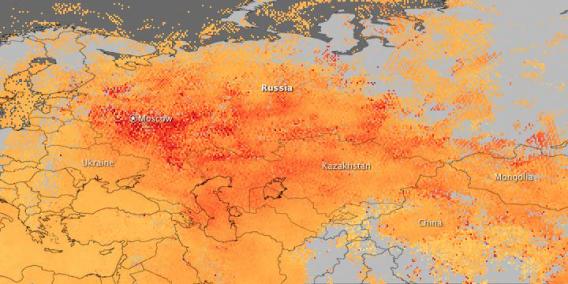A new series of images released by NASA show the extent of smoke hovering over Moscow and Central European Russia, while another image measures the amount of carbon monoxide in the area, a gas which can produce a number of health problems. Russia is in the midst of a full-scale disaster as hundreds of forest and peatland fires are covering part of the world’s largest nation in a thick cloud of smoke. Temperatures in Moscow and elsewhere have broken past heat records several times in the last month while a long drought combined with fires have led to the loss of 20 percent of Russia’s grain crop, causing Prime Minister Vladimir Putin to ban grain exports. Russian officials say that it;s likely some 15,000 people to date have died from the disaster.
Officials announced today that forest contaminated with radiation by the nuclear disaster Chernobyl have burned, leading to fears that the smoke could spread radiation. However, measurements in Moscow have shown nuclear radiation levels as normal.
Russian President Dmitry Medvedev has linked the disaster to climate change. Last Thursday, he told a Russian Security Council meeting, “Everyone is talking about climate change now. Unfortunately, what is happening now in our central regions is evidence of this global climate change, because we have never in our history faced such weather conditions in the past. This means that we need to change the way we work, change the methods that we used in the past.”
His statements are particularly notable as Russia, including Medvedev, has been slow to acknowledge climate change as a pressing concern.
Medvedev’s statements have been supported in part by climatologists, who caution that while a single weather event cannot be blamed on climate change, a pattern of more extreme weather—including worsening droughts in some regions and more extreme flooding in others—are consistent with climate change expectations.
Jeff Knight a climate variability scientist with the UK Met Office told the BBC that climate change was one of a number of factors that have led to Russia’s current disaster.
“Some long-term records have been broken—for example the highest daily temperature in Moscow. We expect more extreme high temperatures as the climate changes. This means that when weather fluctuations promote high temperatures… there is more likelihood of records being broken,” he explains.
Already this year 17 nations, including Russia, have seen past heat records met or exceeded.

Image of Russia and nearby areas from August 4th, 2010 by the Moderate Resolution Imaging Spectroradiometer. Especially intense fires are outlines in red. Photo by: NASA. Click to enlarge.

Also taken on August 4th, 2010, this image shows the full scale of the smoke plume spreading 1,860 miles (3,000 kilometers). The photo was taken by the Moderate Resolution Imaging Spectroradiometer Photo by NASA. Click to enlarge.
Made from the Measurements of Pollution in the Troposphere sensor on NASA’s Terra satellite, this image reveals the amount of carbon monoxide in western Russia from August 1st through August 8th, 2010. The highest levels of carbon measured are shown in red. Areas where the sensor could not reach due to cloud cover are gray. Released from the forest and peatland fires, carbon monoxide can pose serious health risks to people. Image by NASA. Click to enlarge.
Related articles
Summer from hell: seventeen nations hit all-time heat records
(08/09/2010) The summer isn’t over yet, but already seventeen nations have matched or beaten their all-time heat records. According to Jeff Masters’ WunderBlog, Belarus, the Ukraine, Cyprus, Russia, Finland, Qatar, the Sudan, Saudi Arabia, Niger, Chad, Kuwait, Iraq, Pakistan, Colombia, Myanmar, Ascension Island, and the Solomon Islands have all equaled or broken their top temperature records this year. In addition, the hottest temperature ever recorded in Asia was taken in Pakistan at 128 degrees Fahrenheit (53 degrees Celsius); this incredible temperature still has to be reviewed by the World Meteorological Organization (WMO).
Officials point to Russian drought and Asian deluge as consistent with climate change
(08/08/2010) Government officials are pointing to the drought and wildfires in Russia, and the floods across Central and East Asia as consistent with climate change predictions. While climatologists say that a single weather event cannot be linked directly to a warming planet, patterns of worsening storms, severer droughts, and disasters brought on by extreme weather are expected as the planet warms.
Record highs, forest fires, and ash-fog engulf Moscow
(07/27/2010) Moscow and parts of Russia have been hit by record high temperatures and forest fires. Ashen fog from peat forests burning near Moscow has prompted officials to warn elderly and those with heart or bronchial problems to stay inside. Workers should be allowed a siesta to rest in the afternoon, as well, said the Russia’s chief health official.
